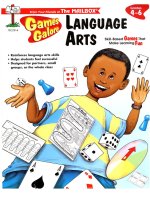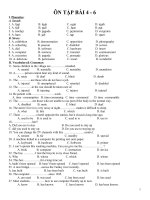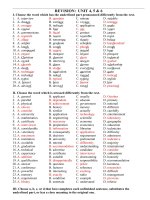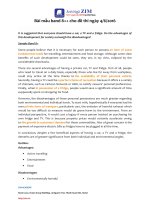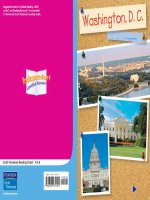4 6 rails across america
Bạn đang xem bản rút gọn của tài liệu. Xem và tải ngay bản đầy đủ của tài liệu tại đây (2.07 MB, 10 trang )
Fascinating Facts
• In the 1820s many of the nation’s railcars were
pulled along their tracks by teams of horses.
• The city of Cheyenne, Wyoming, was built by
Union Pacific workers as a place to live while
working in the area.
• When trains first became popular, some doctors
warned that riding them at such fast speeds
was not healthy.
Genre
Nonfiction
Comprehension Skill
Sequence
Text Features
• Map
• Sidebar
• Captions
Scott Foresman Social Studies
ISBN 0-328-14864-4
ì<(sk$m)=beigeg< +^-Ä-U-Ä-U
In this book you will read about the first
railroad to cross the United States from coast
to coast. The railroad allowed people to travel
from east to west quickly, cheaply, and safely.
Write to It!
Think about what it might have been like to
help build the transcontinental railroad. Write
the words to a short song using a tune you
know. Your song should inspire you and the
other workers to do your job well.
Vocabulary
transcontinental railroad
transportation
engineer
Write your song on a separate sheet of paper.
immigrants
Maps
MapQuest, Inc.
Photographs
Every effort has been made to secure permission and provide appropriate credit for photographic material. The publisher deeply
regrets any omission and pledges to correct errors called to its attention in subsequent editions.
Unless otherwise acknowledged, all photographs are the property of Scott Foresman, a division of Pearson Education.
Photo locators denoted as follows: Top (T), Center (C), Bottom (B), Left (L), Right (R) Background (Bkgd)
ISBN: 0-328-14864-4
Copyright © Pearson Education, Inc.
All Rights Reserved. Printed in the United States of America. This publication is protected
by Copyright, and permission should be obtained from the publisher prior to any prohibited
reproduction, storage in a retrieval system, or transmission in any form by any means,
electronic, mechanical, photocopying, recording, or likewise. For information regarding
permission(s), write to: Permissions Department, Scott Foresman, 1900 East Lake Avenue,
Glenview, Illinois 60025.
1 2 3 4 5 6 7 8 9 10 V0G1 14 13 12 11 10 09 08 07 06 05
Opener: ©Bettmann/Corbis, (Bkgd) ©Getty Images
Editorial Offices: Glenview, Illinois • Parsippany, New Jersey • New York, New York
2 ©Getty Images
3 ©Underwood & Underwood/Corbis
Sales Offices: Needham, Massachusetts • Duluth, Georgia • Glenview, Illinois
4 ©Bettmann/Corbis
Coppell, Texas • Sacramento, California • Mesa, Arizona
5 ©K.J. Historical/Corbis
6 ©Bettmann/Corbis
8 ©Bettmann/Corbis
10 ©Huntington Library/SuperStock
14 ©The Granger Collection, NY
15 ©Bettmann/Corbis
Moving West
In May 1869 the nation’s first transcontinental
railroad was finished. The railroad stretched from
coast to coast. Now people could travel across the
country in ten days or less.
Before 1869 people had only a few ways to travel
west. Some sailed around the tip of South America
or to Panama and back up along the Pacific coast.
Others rode across the country in covered wagons.
Those methods of transportation took many months.
Railroad owners were sure that trains would
replace horses.
Travel Today
Today people have many choices when they
travel across the country. Many choose to fly
because it is the fastest way. Others drive their
cars, take a bus, or go by train.
2
The Transcontinental
Railroad
A transcontinental railroad was first suggested in
1832. However, many people thought the idea was
impossible. At that time the longest railroad track was
only 136 miles long.
During the 1800s many people believed that the
United States would expand to the Pacific Ocean. In
1848 the country gained land in the Southwest after
winning a war against Mexico. California became a
state in 1850.
3
In 1853 the United States government sent
engineers to study possible routes for a
transcontinental railroad. While Congress argued
about which route was best, a railroad engineer
named Theodore Judah took action.
In 1861 Judah convinced four California
businesspeople to form the Central Pacific Railroad
Company. They became known as the “Big Four.”
This postcard shows the first engine to run on the Central
Pacific Railroad from Sacramento, California.
In 1862 Congress passed the Pacific Railway
Act. It gave the Central Pacific the right to lay tracks
going eastward. The government also created the
Union Pacific Railroad Company to lay tracks going
westward. The two lines would meet somewhere in the
middle.
Leland Stanford was one
of the ”Big Four.” He was
a state governor.
4
5
Building the Railroad
In January 1863, Central Pacific officials and
workers met in Sacramento, California. Many steps
went into building the railroad. Engineers chose the
best path. Workers cleared away trees and stones.
They placed crossties, or wooden beams that connect
and support the rails of a railroad, into the ground.
They then hammered iron rails onto the crossties with
spikes.
On the Central Pacific
Railroad
The Central Pacific had hundreds of miles of track to
lay, but not enough workers. The work was hard and
dangerous. By early 1865 only a few hundred Irish
immigrants had jobs as the railroad crew.
The Central Pacific solved its problem by hiring
Chinese immigrants. By the time the railroad was
finished, about ten thousand Chinese immigrants had
done most of the work.
Many workers on the
transcontinental railroad
were Chinese immigrants.
6
7
During the winter
of 1866–1867,
snowslides killed
dozens of workers.
Crossing the Sierra Nevada
The Central Pacific crews faced the hardest part of
their job after they left Sacramento. They had to lay
tracks across the Sierra Nevada.
Crews worked six days a week. They blew up
cliffs and dug tunnels through rock. Crews used
picks, shovels, axes, animals, wheelbarrows, and
gunpowder to do the job.
8
The winter of 1866–1867 was harsh. There were
freezing temperatures, piles of snow, and dozens of
storms. The men lived in tunnels underneath the snow
or in shacks on the mountain. That winter the track
moved forward only about eight inches a day.
9
Work on the Union Pacific
The Race to Utah
By the end of 1863, the Union Pacific rail line
reached as far west as Omaha, Nebraska. The Civil
War delayed more work until 1865.
Workers on the Union Pacific faced problems from
American Indians, or Native Americans, who lived
in the region. The railroad tracks ran through buffalo
hunting grounds, causing the American Indians to
attack the railroad crews.
By 1868 the Central Pacific rail line extended
eastward from the Sierra Nevada. The rail lines made
by both companies were now on flat land. Workers on
both sides rushed to complete the most track.
In 1869 both companies were working on tracks
that did not connect. The government forced officials
from the two companies to meet. The officials
picked a spot where the railroad tracks would join:
Promontory, Utah.
Sometimes long
wooden structures
called trestles were
built to carry the rail
line across valleys.
10
11
The two railroad crews now raced to be first to
reach Promontory Summit. One day, workers from
the Central Pacific laid six miles of track. Soon after,
the Union Pacific crews laid seven miles of track in
one day.
On April 28, 1869, a Central Pacific crew worked
from sunrise until seven o’clock at night. It set a record
by completing more than ten miles of track in one day.
On April 30 the Central Pacific workers reached
Promontory and won the race to the end. The next
day the Union Pacific crews came within sight of
Promontory. The transcontinental railroad was almost
done. In six years workers had built 1,776 miles of
track.
The First Transcontinental Railroad, 1869
CANADA
Pa
l
tra
Ce n
Sacramento
Uni
o n Pa c
i f ic
Omaha
San
Francisco
N
MEXICO
0
0
12
cific
250
250
500 Miles
500 Kilometers
13
Done!
The railroad companies planned a big celebration
in Utah. On May 10, 1869, only one more spike
was needed to connect the two rail lines. Workers,
officials, reporters, and guests gathered at the site.
The last spike was made of solid gold. The news
went out: “Done!” People around the country joined
in the celebration. They made speeches, held parades,
and rang bells.
Early train travel offered a new level of speed and comfort
for travelers.
Traveling Out West
People from all over the country wanted to ride
along the new route. Each week, one train headed
west and another headed east.
The transcontinental railroad opened up the
United States to tourists, travel reporters, and people
looking for jobs. Soon even more railroads connected
communities from coast to coast.
The completion of the transcontinental railroad opened up
travel to the West.
14
15
In this book you will read about the first
railroad to cross the United States from coast
to coast. The railroad allowed people to travel
from east to west quickly, cheaply, and safely.
Glossary
Write to It!
engineer a person who uses scientific and
mathematical ideas to design, make, and
run structures and machines
Vocabulary
immigrant a person
who comes to live in a
transcontinental railroad
new land
transportation
transcontinental
railroad a railroad that
crosses a continent
engineer
Think about what it might have been like to
help build the transcontinental railroad. Write
the words to a short song using a tune you
know. Your song should inspire you and the
other workers to do your job well.
Write your song on a separate sheet of paper.
transportationimmigrants
the moving of goods,
people, or animals from one place
to another
Maps
MapQuest, Inc.
Photographs
Every effort has been made to secure permission and provide appropriate credit for photographic material. The publisher deeply
regrets any omission and pledges to correct errors called to its attention in subsequent editions.
Unless otherwise acknowledged, all photographs are the property of Scott Foresman, a division of Pearson Education.
Photo locators denoted as follows: Top (T), Center (C), Bottom (B), Left (L), Right (R) Background (Bkgd)
ISBN: 0-328-14864-4
Copyright © Pearson Education, Inc.
All Rights Reserved. Printed in the United States of America. This publication is protected
by Copyright, and permission should be obtained from the publisher prior to any prohibited
reproduction, storage in a retrieval system, or transmission in any form by any means,
electronic, mechanical, photocopying, recording, or likewise. For information regarding
permission(s), write to: Permissions Department, Scott Foresman, 1900 East Lake Avenue,
Glenview, Illinois 60025.
16
1 2 3 4 5 6 7 8 9 10 V0G1 14 13 12 11 10 09 08 07 06 05
Opener: ©Bettmann/Corbis, (Bkgd) ©Getty Images
2 ©Getty Images
3 ©Underwood & Underwood/Corbis
4 ©Bettmann/Corbis
5 ©K.J. Historical/Corbis
6 ©Bettmann/Corbis
8 ©Bettmann/Corbis
10 ©Huntington Library/SuperStock
14 ©The Granger Collection, NY
15 ©Bettmann/Corbis
